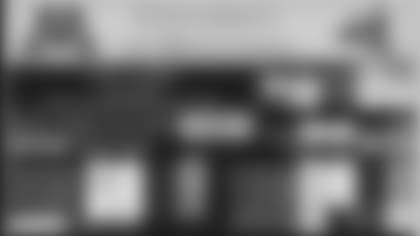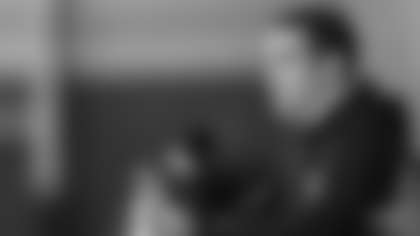This is the sixth in our series of articles taking a deeper dive using data and game with the use of data and game film into the Giants' 2020 draft class. We have already studied Andrew Thomas, Xavier McKinney, Matt Peart, Shane Lemieux and Cam Brown. Here is a look at seventh round pick Carter Coughlin, linebacker out of Minnesota.
Athletic Traits
I like to use two different metrics when evaluating a player's measureables. The first is RAS, which stands for Relative Athletic Score. It is a formula created by Kent Lee Platte and compares a player's measurements and testing during the pre-draft process to everyone else at the position that has been tested since 1987. A 10 is the highest score with 5 being a true average score. You can find all the class's RAS scores at relativeathleticscores.com.

The other useful illustration are the spider graphs posted at mockdraftable.com, which provides a nice visual of what a player's strengths are compared to others at the position. The numbers represent the percentile each player ranks in each category relative to the other players at his position.
Coughlin's athletic profile is impressive. He skipped the bench press and the agility drills at the NFL combine, but he excelled in the tests he did. His broad jump (10 feet, 6 inches) and vertical jump (36 inches) were excellent, with the former landing him in the 90th percentile of linebackers.
His 40-yard dash (4.57) and 10-yard split (8.16) were both in the 80th percentile of linebackers. The strong results in the straight ahead running drills and explosive leaping drills show a player who has a good first step and short area explosiveness. It should be no surprise he excelled as an edge rusher in Minnesota's defense.
He is 6-3 but is light for an edge rusher at only 236 pounds. His 31 3/8 inch arms are also short by NFL edge rusher standards. Those numbers are why in both comparison metrics above, he is being treated as a linebacker in the NFL rather than an edge rusher.
College History (Advanced Production Numbers Courtesy of Pro Football Focus)
2016: Redshirt Freshman Season – 11 games with one start as an edge rusher
PFF Numbers: 25 tackles, 4 tackles for loss, 2 sacks, 6 QB Hits and 10 QB Hurries in 100 pass rushing snaps
2017: Sophomore Season – 12 games started, Honorable Mention All-Big 10, Academic All-Big 10
PFF Numbers: 37 tackles, 11.5 tackles for loss, 1 forced fumble, 6.5 sacks, 8 QB hits and 9 QB hurries in 247 pass rush snaps
2018: Junior Season – 13 games with 13 starts, 2nd Team All-Big 10, Academic All-Big 10
PFF Numbers: 48 tackles, 15 tackles for loss, 4 forced fumbles, 9.5 sacks, 16 quarterback hits, and 29 QB hurries in 342 pass rushing snaps.
2019: Senior Season – 13 games with 13 starts, 2nd Team All-Big 10, Academic All-Big 10
PFF Numbers: 49 tackles, 9.5 tackles for loss, 2 forced fumbles, 4 passes defended, 4.5 sacks, 10 QB hits, and 37 QB hurries in 295 pass rush snaps
Carter Coughlin attended the Senior Bowl.
Overall: 145th on PFF's big board – 5th round projection
Injuries: He had no significant injuries reported in college and he played in all of Minnesota's games in his last three seasons.
Athletic Background: Coughlin was a four star recruit and the 8th ranked outside linebacker in the country in his recruiting class. He lettered in both football and basketball in high school. He played defensive line, linebacker and some offense in high school. He lost only one game in three years of varsity football.
Coughlin's family has a long history of athletics at the University of Minnesota. His father played defensive tackle from 1986-1990, his mother was a two-time tennis MVP from 1989-1992, his maternal grandfather and maternal uncle both played football (his grandfather also played baseball), and his cousin, Cole Kramer, redshirted his freshman year.
Film Study
Coughlin was primarily Minnesota's right defensive end or stand-up rusher in their 4-3 system, though he did also play on the left side.
We'll start with his pass rushing. Here's a play where he wins outside against the opponent's left tackle and shows dip and bend on his way to the scrambling quarterback.
Here's a counter to show the ability to use his quickness to win inside.
On this play, Coughlin lines up at left end. He doesn't win on his initial pass rush move but stays aware to see the quarterback scrambling to try to convert a third and short. He gets off the block and prevents the scramble for the first down.
Against the run, Coughlin shows discipline and an ability to play his assignments perfectly. On this play, Coughlin takes on the pulling left guard, discards him, and makes the play in the hole.
Coughlin shows his strength playing left end on these next two plays. He uses his strength to shock the tight end, push him back and off him, to free himself up to move down the line and tackle the ball carrier.
Coughlin shows excellent discipline on this read-option, not falling for the fake to running back. He maintains his gap responsibility and takes down the ball carrier.
Finally – here is a play that shows Coughlin's range. Despite him taking a false step inside, he gets to the perimeter fast enough to prevent the offensive player from turning the corner and getting upfield.
Coughlin was an excellent college player, but the position he excelled at will be difficult to play in the NFL with shorter arms and weighing only 230 pounds. He may have to transition to an off-ball linebacker position. His testing says he can do it and it will be fun to see how Patrick Graham utilizes his strengths in the Giants defense. He should also be a contributing factor on special teams.

Giants App
Download the Giants' official app for iPhone, iPad and Android devices






